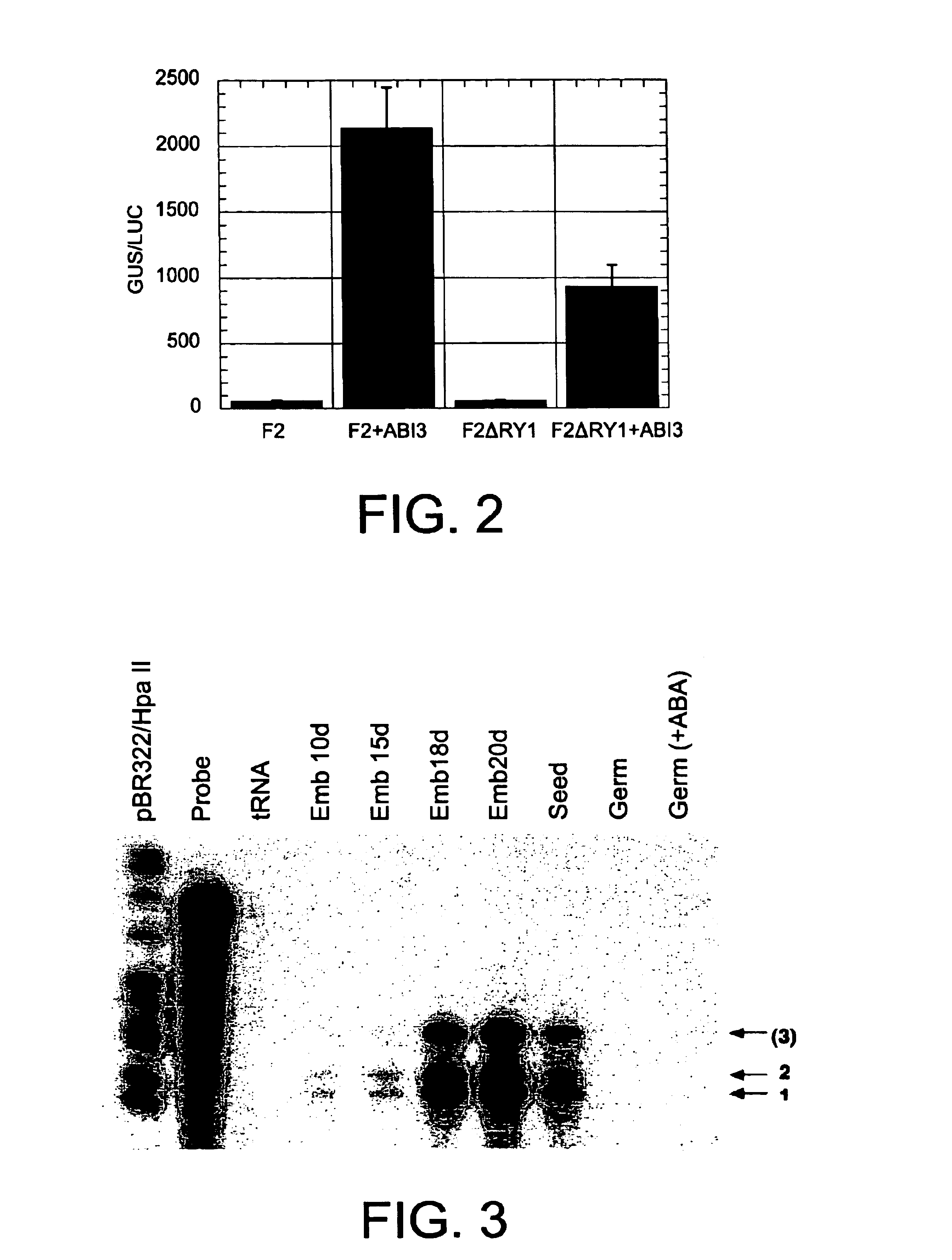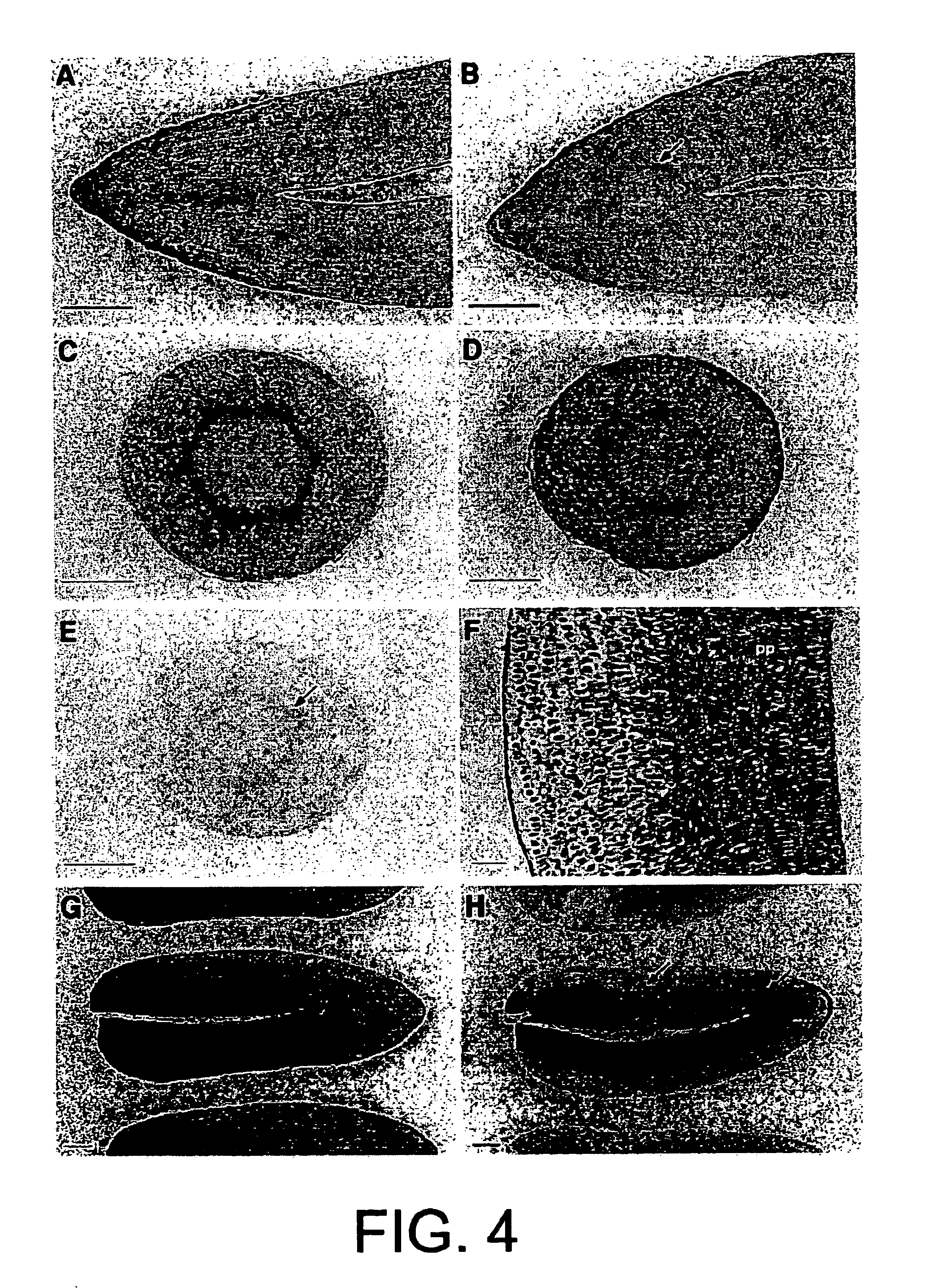Promoter and regulator sequences Ha ds10 G1: a gene lea of sunflower expressed exclusively in seeds from the maturation phase
a gene lea and promoter technology, applied in the field of promoter and regulator sequences, can solve the problems of limited specific use, inability to use in genetic engineering, and inability to obtain regulatory dna sequences, so as to reduce gus activity, improve expression efficiency, and improve the effect of gus expression
- Summary
- Abstract
- Description
- Claims
- Application Information
AI Technical Summary
Benefits of technology
Problems solved by technology
Method used
Image
Examples
example 1
Cloning, Determination of Restriction Map, Nucleotide Sequence and Analysis of the Ha ds10 G1 Promoter
To obtain the Ha ds10 G1 clone, the sunflower genomic DNA gene library described by Coca et al. [Plant Mol. Biol. 31: 863-876, 1996] was screened, with the probe corresponding to total Ha ds10 cDNA [Almoguera and Jordano, Plant Mol. Biol. 19: 781-792, 1992]; using standard hybridisation conditions and molecular cloning procedures described in detail in the first reference of Coca et al., 1996. A phage (IGEM11) with a sunflower genonic DNA insert of approximately 16.5 Kb--whose partial map is shown in FIG. 1--was isolated. Using restriction analysis it was determined that the two fragments adjacent to the Sac I site (4.2 and 9.3 Kb) contain the sequences that hybridise with the cDNA. A detailed restriction map of the first of these fragments was determined and part (4 Kb) of the second (FIG. 1). Different genomic DNA subfragments, corresponding to the mapped region, were cloned in pB...
example 2
Accumulation and Specific Localisation of Ha ds10 mRNA in Sunflower Embryos
The messenger RNA accumulation patterns of the Ha ds10G1 gene were determined by the Ribonuclease A (RNAse) protection technique, described in detail by Almoguera et al. [Almoguera C, Coca M A, Jordano J. Plant Physiol. 107: 765-773, 1995]. To do this, total RNA samples prepared from seed embryos at different stages of development, under normal growth conditions, were used [Almoguera and Jordano, Plant Mol. Biol. 19: 781-792, 1992; Coca et al., Plant Mol. Biol. 25: 479-492, 1994]; from 3-day seedlings after imbibition (dpi); and from different adult plant organs before flowering. The seedling and plant RNA were prepared from plant material obtained both under controlled growth conditions [Almoguera and Jordano, Plant Mol. Biol. 19: 781-792, 1992; Coca M A, Almoguera C, and Jordano J. Plant Mol. Biol. 25: 479-492, 1994; Coca M A, Almoguera C, Thomas T L, and Jordano J. Plant Mol. Biol. 31: 863-876, 1996], and ...
example 3
Construction of ds10G1::GUS Chimeric Genes and Their Analysis in Tobacco Transgenic Plants
As an example of the possible uses of the promoter and the regulatory sequences of Ha ds10 G1 gene in the construction of chimeric genes with specific expression in transgenic plant seeds, the construction and analysis of 4 ds10G1::GUS translational fusions in tobacco transgenic plants (FIG. 5) are described below. These fusions contain the promoter and different combinations of flanking and intragenic sequences of Ha ds10 G1 gene for its functional analysis. These 4 fusions provide high levels of expression of the reporter gene (GUS) in seeds from early maturation stages (FIG. 6), confirming the observations in the homologous system (Example 2, FIGS. 1-4).
The first of these constructions, ds10F1 (FIG. 5) was obtained from the ds10G1S3 plasmid (FIG. 1), which contains the genomic sequences of Ha ds10 G1 between Sal I (-1576) and Eco RI (+1086), subcloned into the corresponding restriction sites...
PUM
| Property | Measurement | Unit |
|---|---|---|
| Bioactive | aaaaa | aaaaa |
Abstract
Description
Claims
Application Information
 Login to view more
Login to view more - R&D Engineer
- R&D Manager
- IP Professional
- Industry Leading Data Capabilities
- Powerful AI technology
- Patent DNA Extraction
Browse by: Latest US Patents, China's latest patents, Technical Efficacy Thesaurus, Application Domain, Technology Topic.
© 2024 PatSnap. All rights reserved.Legal|Privacy policy|Modern Slavery Act Transparency Statement|Sitemap



